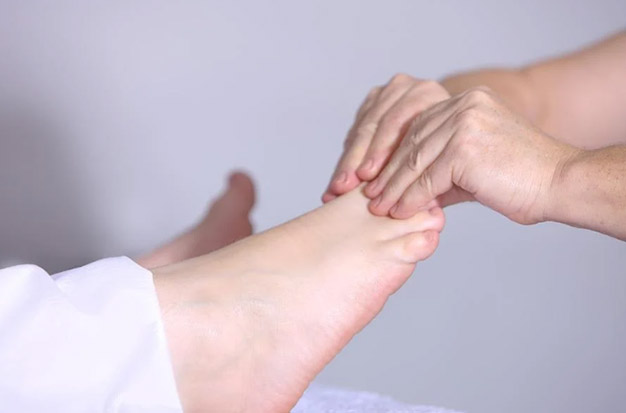Massage for Plantar Fasciitis – How Does It Work?

Plantar fasciitis massage is an excellent way to manage foot pain, swelling, and stiffness whether you’re looking for professional assistance or prepared to try some do-it-yourself techniques. For a thorough massage that can target the foot arch, heels, and calves, it’s important to find the best methods and equipment. For detailed instructions on how to begin, refer to our guide.
What Is Plantar Fasciitis?
The plantar fascia is a substantial band of connective tissue that runs the entire length of the foot’s medial longitudinal arch. It ties the toe ligaments and the heel bone (calcaneus bone) together. When walking and running, the plantar fascia is crucial for controlling gait and absorbing shock. The foot arches are produced by the plantar fascia. High arches may develop if the fascia is pulled too firmly. Flat feet can develop if it is too relaxed. It is also in charge of dorsiflexion, which is the upward, flexed-toward-the-shin movement of the foot. The plantar fascia becomes inflamed when someone has plantar fasciitis. It can be crippling because standing and walking can become excruciatingly painful. Even though pain may be felt anywhere along the fascia, inflammation typically concentrates at the point where the fascia connects to the calcaneus bone.
How Massage Can Help Plantar Fasciitis
Heel pain is frequently brought on by plantar fasciitis. Plantar fasciitis is an inflammation of the plantar fascia, a thick band of tissue on the bottom of your foot. It frequently causes pain in the arch or heel of your foot, and occasionally both. Fortunately, it has been demonstrated that regular massage can help reduce plantar fasciitis symptoms. It promotes healing by increasing blood flow to the area.
The best results come from massaging your feet twice daily, but even one massage per day is preferable to none. That being said, stretching in addition to your massage routine can help further reduce pain and improve overall mobility, and podiatrists agree that stretching is one of the best massage routines. Regular massages are essential for the best results, just as you must exercise frequently and eat healthily to start seeing results.
How Do You Manage The Pain Caused By Plantar Fasciitis?
According to the American Academy of Orthopaedic Surgeons, a staggering 2 million people receive treatment for the excruciating heel condition plantar fasciitis each year. Running, walking, or even standing still for extended periods of time can aggravate the condition, which is brought on by inflammation of the plantar fascia, the thick band of tissue that supports the arch and connects the toes to the heel bone. Plantar fasciitis can become chronic if left untreated and is also excruciatingly painful.
If you experience plantar fasciitis pain, you’re probably already aware of a number of treatment options, including donning podiatrist-recommended footwear, putting insoles in your footwear, dozing off in a night splint, and taking over-the-counter painkillers. Giving yourself a foot massage, however, is another easy and non-invasive way to treat plantar fasciitis pain if you want to feel better right away after spending all day on your feet. Cross-fiber massage therapy is recommended by Jacqueline Sutera, DPM, a podiatric surgeon at City Podiatry in New York City, to treat plantar fasciitis. In fact, it’s simple to do and very successful at treating pain.
When and How Often Should You Massage Affected Area?
To break up the constant pain and promote maximum healing, massage the area as often as tolerated. Massages are most effective in the morning, just after waking up and before physical activity. This will lessen pain and tightness before the activity, and regular massage practice will help with long-term pain management that is effective.
What Kind Of Massage Treats Plantar Fasciitis Best?
With slow, powerful strokes, deep tissue massage therapy targets the underlying musculature. It aids in the process of healing by easing tension in the foot and removing scar tissue. Specific areas of the heel and arch are massaged, which can cause slight soreness the next few days. It is a powerful method for easing the discomfort of plantar fasciitis and stopping its painful condition’s further progression.
It is crucial to concentrate on the area with the most pain when treating plantar fasciitis, with nearby muscle groups receiving secondary attention. Start by concentrating on the region where the ligament meets the heel bone on the underside of the arch close to the heel. After that, proceed to the Achilles tendon by starting at the heel’s base and working your way up to the calf.

Safe Massage For Plantar Fasciitis
One of the best treatments for plantar fasciitis is massage therapy, which helps to reduce stiffness, target trigger points, and treat chronic pain in the heel. Your primary concern when beginning should be how to apply massage correctly and safely. We advise that you consult a doctor if your pain does not subside or becomes more severe. Regular massage will help you stay on top of symptoms and can even be an effective treatment for heel spurs and flat feet when combined with stretching and exercise. These plantar fasciitis massage techniques and tools will be effective for you whether you seek out a physical therapist to use them or decide to use them on your own.
- Scraping along the plantar fascia
- Thumb presses
- Thumb pulls
- Toe pull stretch
- Ice and heat massage
Although having access to massage therapists can be beneficial for recovery, it’s not always convenient or affordable. We think it’s important for you to be as proactive as you can with your recovery. You can manage your physically demanding day by incorporating a few of the massage recommendations mentioned above to relieve your plantar fasciitis pain at home.
Finally, using massage in conjunction with other forms of treatment is a fantastic way to help manage your pain. Check out our post on the best tools for plantar fasciitis for maximum relief if you’re looking for additional treatment options. Despite how frustrating plantar fasciitis can be, know that many people have overcome it, and you can too.
Self-massage Techniques For Plantar Fasciitis
Self-massage for plantar fasciitis techniques can provide short-term relief from heel pain. Even without using a specific technique, applying pressure to the painful area can frequently provide some relief. Applying pressure evenly to the plantar fascia may be made easier by using a massage tool. You can test your pain tolerance by rolling tennis and golf balls under your feet. Pressure relief and analgesic cooling can both be achieved with the help of a water bottle filled with cold water (or ice, wrapped in a towel).
On the painful foot, cross-fiber techniques and deep tissue massage can be applied. The affected foot should be brought within reach, with the ankle resting on the thigh on the opposite side, as the patient should sit comfortably. Working down toward the Achilles, massage the back of the calf with both hands. Although it may be painful to work cross fiber close to the Achilles, it may be tolerable for a short period of time. The next area to focus on is where the foot’s arch and heel meet.
Read More:What Is the Difference Between Thai Massage & Deep Tissue?
Conclusion
By performing regular exercises, you can increase the flexibility of your foot once the inflammation has been brought under control. Two easy but efficient exercises to increase the flexibility and strength of the ankle, calf, and inner sole are the towel calf stretch and the plantar fascia stretch. Use an ice bottle massage after working out to reduce swelling.
Find More Message Therapy Here!
Tags: Massage, Massage for Plantar Fasciitis, Plantar Fasciitis








